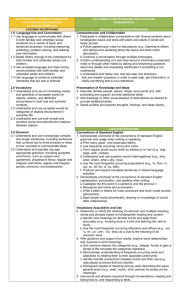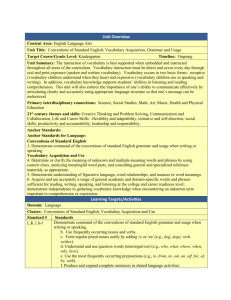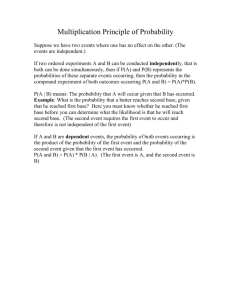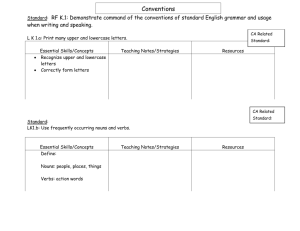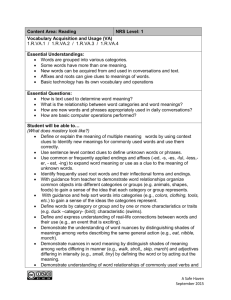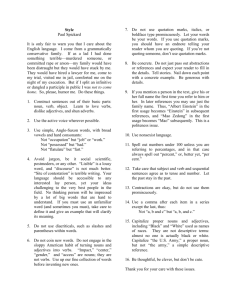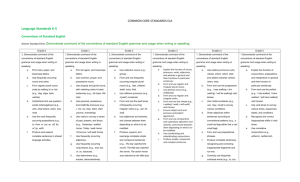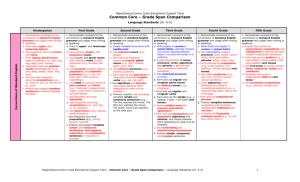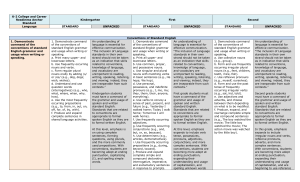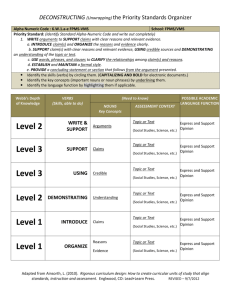nouns meaning
advertisement
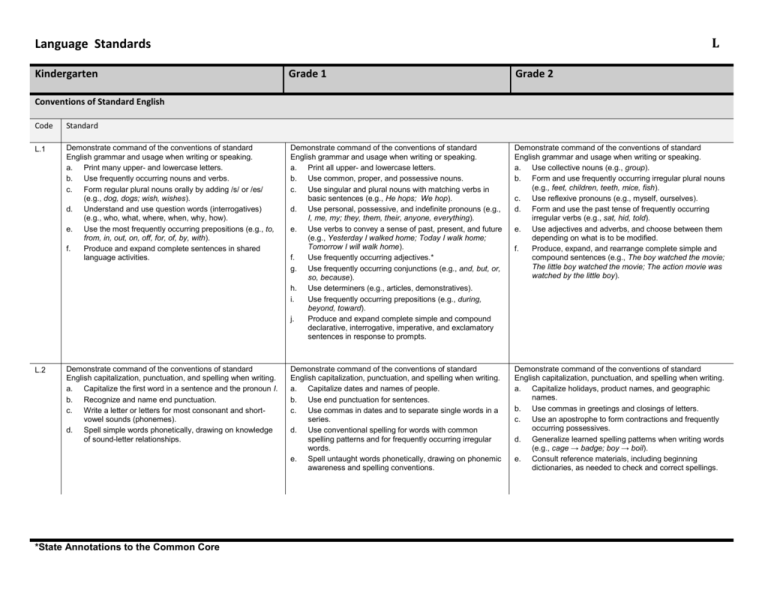
L Language Standards Kindergarten Grade 1 Grade 2 Conventions of Standard English Code Standard L.1 Demonstrate command of the conventions of standard English grammar and usage when writing or speaking. a. Print many upper- and lowercase letters. b. Use frequently occurring nouns and verbs. c. Form regular plural nouns orally by adding /s/ or /es/ (e.g., dog, dogs; wish, wishes). d. Understand and use question words (interrogatives) (e.g., who, what, where, when, why, how). e. Use the most frequently occurring prepositions (e.g., to, from, in, out, on, off, for, of, by, with). f. Produce and expand complete sentences in shared language activities. Demonstrate command of the conventions of standard English grammar and usage when writing or speaking. a. Print all upper- and lowercase letters. b. Use common, proper, and possessive nouns. c. Use singular and plural nouns with matching verbs in basic sentences (e.g., He hops; We hop). d. Use personal, possessive, and indefinite pronouns (e.g., I, me, my; they, them, their, anyone, everything). e. Use verbs to convey a sense of past, present, and future (e.g., Yesterday I walked home; Today I walk home; Tomorrow I will walk home). f. Use frequently occurring adjectives.* g. Use frequently occurring conjunctions (e.g., and, but, or, so, because). h. Use determiners (e.g., articles, demonstratives). i. Use frequently occurring prepositions (e.g., during, beyond, toward). j. Produce and expand complete simple and compound declarative, interrogative, imperative, and exclamatory sentences in response to prompts. Demonstrate command of the conventions of standard English grammar and usage when writing or speaking. a. Use collective nouns (e.g., group). b. Form and use frequently occurring irregular plural nouns (e.g., feet, children, teeth, mice, fish). c. Use reflexive pronouns (e.g., myself, ourselves). d. Form and use the past tense of frequently occurring irregular verbs (e.g., sat, hid, told). e. Use adjectives and adverbs, and choose between them depending on what is to be modified. f. Produce, expand, and rearrange complete simple and compound sentences (e.g., The boy watched the movie; The little boy watched the movie; The action movie was watched by the little boy). L.2 Demonstrate command of the conventions of standard English capitalization, punctuation, and spelling when writing. a. Capitalize the first word in a sentence and the pronoun I. b. Recognize and name end punctuation. c. Write a letter or letters for most consonant and shortvowel sounds (phonemes). d. Spell simple words phonetically, drawing on knowledge of sound-letter relationships. Demonstrate command of the conventions of standard English capitalization, punctuation, and spelling when writing. a. Capitalize dates and names of people. b. Use end punctuation for sentences. c. Use commas in dates and to separate single words in a series. d. Use conventional spelling for words with common spelling patterns and for frequently occurring irregular words. e. Spell untaught words phonetically, drawing on phonemic awareness and spelling conventions. Demonstrate command of the conventions of standard English capitalization, punctuation, and spelling when writing. a. Capitalize holidays, product names, and geographic names. b. Use commas in greetings and closings of letters. c. Use an apostrophe to form contractions and frequently occurring possessives. d. Generalize learned spelling patterns when writing words (e.g., cage → badge; boy → boil). e. Consult reference materials, including beginning dictionaries, as needed to check and correct spellings. *State Annotations to the Common Core L Language Standards Kindergarten Grade 1 Grade 2 (Begins in grade 2) Use knowledge of language and its conventions when writing, speaking, reading, or listening. a. Compare formal and informal uses of English. L.1.1f: Adjectives include size. Knowledge of Language Code Standard L.3 (Begins in grade 2) Vocabulary Acquisition and Use Code Standard L.4 Determine or clarify the meaning of unknown and multiplemeaning words and phrases based on kindergarten reading and content. a. Identify new meanings for familiar words and apply them accurately (e.g., knowing duck is a bird and learning the verb to duck). b. Use the most frequently occurring inflections and affixes (e.g., -ed, -s, re-, un-, pre-, -ful, -less) as a clue to the meaning of an unknown word. Determine or clarify the meaning of unknown and multiplemeaning words and phrases based on grade 1 reading and content, choosing flexibly from an array of strategies. a. Use sentence-level context as a clue to the meaning of a word or phrase. b. Use frequently occurring affixes as a clue to the meaning of a word. c. Identify frequently occurring root words (e.g., look) and their inflectional forms (e.g., looks, looked, looking). Determine or clarify the meaning of unknown and multiplemeaning words and phrases based on grade 2 reading and content, choosing flexibly from an array of strategies. a. Use sentence-level context as a clue to the meaning of a word or phrase. b. Determine the meaning of the new word formed when a known prefix is added to a known word (e.g., happy/unhappy, tell/retell). c. Use a known root word as a clue to the meaning of an unknown word with the same root (e.g., addition, additional). d. Use knowledge of the meaning of individual words to predict the meaning of compound words (e.g., birdhouse, lighthouse, housefly; bookshelf, notebook, bookmark). e. Use glossaries and beginning dictionaries, both print and digital, to determine or clarify the meaning of words and phrases. L.5 With guidance and support from adults, explore word relationships and nuances in word meanings. a. Sort common objects into categories (e.g., shapes, foods) to gain a sense of the concepts the categories represent. b. Demonstrate understanding of frequently occurring verbs and adjectives by relating them to their opposites (antonyms). c. Identify real-life connections between words and their use (e.g., note places at school that are colorful). d. Distinguish shades of meaning among verbs describing the same general action (e.g., walk, march, strut, prance) With guidance and support from adults, demonstrate understanding of word relationships and nuances in word meanings. a. Sort words into categories (e.g., colors, clothing) to gain a sense of the concepts the categories represent. b. Define words by category and by one or more key attributes (e.g., a duck is a bird that swims; a tiger is a large cat with stripes). c. Identify real-life connections between words and their use (e.g., note places at home that are cozy). d. Distinguish shades of meaning among verbs differing in manner (e.g., look, peek, glance, stare, glare, scowl) and Demonstrate understanding of word relationships and nuances in word meanings. a. Identify real-life connections between words and their use (e.g., describe foods that are spicy or juicy). b. Distinguish shades of meaning among closely related verbs (e.g., toss, throw, hurl) and closely related adjectives (e.g., thin, slender, skinny, scrawny). L Language Standards Kindergarten by acting out the meanings. Grade 1 Grade 2 adjectives differing in intensity (e.g., large, gigantic) by defining or choosing them or by acting out the meanings. Vocabulary Acquisition and Use, continued Code Standard L.6 Use words and phrases acquired through conversations, reading and being read to, and responding to texts. Use words and phrases acquired through conversations, reading and being read to, and responding to texts, including using frequently occurring conjunctions to signal simple relationships (e.g., because). Use words and phrases acquired through conversations, reading and being read to, and responding to texts, including using adjectives and adverbs to describe (e.g., When other kids are happy that makes me happy).
